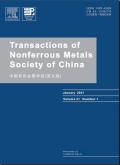纯钴中fcc→hcp相变取向偏差的成因及原位验证
IF 4.7
1区 材料科学
Q1 METALLURGY & METALLURGICAL ENGINEERING
Transactions of Nonferrous Metals Society of China
Pub Date : 2025-05-01
DOI:10.1016/S1003-6326(25)66765-3
引用次数: 0
摘要
利用电子背散射衍射(EBSD)技术和转变晶体学模型分析了纯钴中面心立方向六方密堆积转变后取向偏差的成因。结果表明,fcc→hcp转化过程中的Shoji - Nishiyama取向关系导致了4种hcp变异,其特征是常见的取向偏差为70.5°,这是观测到的主要取向偏差。此外,hcp颗粒间的取向偏差还包括32°、36°、38°、60°、71°和86°~ 91°。这些新观察到的错取向角与高温下fcc基体的微观结构有关,其中fcc基体中的孪晶结构是主要原因。在此基础上,提出了一种基于hcp变异体取向角估计fcc晶粒中孪晶分数的新方法,该方法与实验结果一致。现场EBSD观测证实了hcp→fcc转换可能是fcc孪晶的来源。本文章由计算机程序翻译,如有差异,请以英文原文为准。
Origin of misorientations for fcc→hcp transformation in pure cobalt and its in-situ validation
The origin of the misorientations after fcc (face-centered cubic) to hcp (hexagonal close-packed) transformation in pure cobalt was elucidated by utilizing the electron backscatter diffraction (EBSD) technique and transformation crystallographic models. It is found the Shoji−Nishiyama orientation relationship during fcc→hcp transformation leads to four hcp variants, characterized by a common misorientation angle of 70.5° with respect to the direction, which is the predominant misorientation observed. Other statistically significant misorientation angles between hcp grains, including 32°, 36°, 38°, 60°, 71° and 86°−91°, are also identified. These newly observed misorientation angles are linked to the microstructure of the fcc matrix at elevated temperatures, with twin structures in the fcc matrix being the primary cause. Furthermore, a novel method is proposed for estimating the fraction of twins in the fcc grains based on misorientation angles between hcp variants, which is found to be consistent with experimental observations. In-situ EBSD observations validate the possible origin of fcc twins from the hcp→fcc transformation.
求助全文
通过发布文献求助,成功后即可免费获取论文全文。
去求助
来源期刊
CiteScore
7.40
自引率
17.80%
发文量
8456
审稿时长
3.6 months
期刊介绍:
The Transactions of Nonferrous Metals Society of China (Trans. Nonferrous Met. Soc. China), founded in 1991 and sponsored by The Nonferrous Metals Society of China, is published monthly now and mainly contains reports of original research which reflect the new progresses in the field of nonferrous metals science and technology, including mineral processing, extraction metallurgy, metallic materials and heat treatments, metal working, physical metallurgy, powder metallurgy, with the emphasis on fundamental science. It is the unique preeminent publication in English for scientists, engineers, under/post-graduates on the field of nonferrous metals industry. This journal is covered by many famous abstract/index systems and databases such as SCI Expanded, Ei Compendex Plus, INSPEC, CA, METADEX, AJ and JICST.

 求助内容:
求助内容: 应助结果提醒方式:
应助结果提醒方式:


